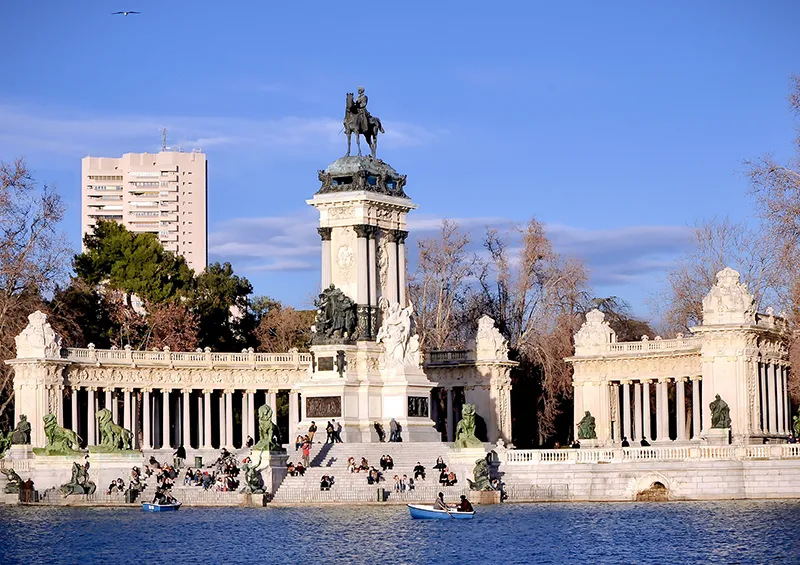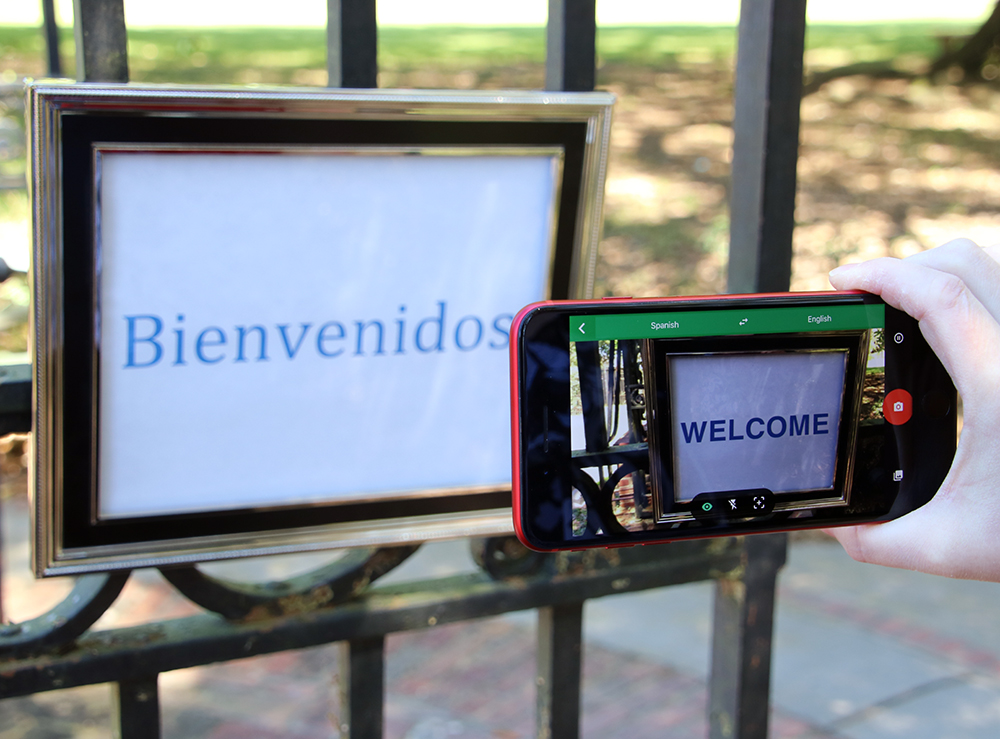
Last March, I was in Madrid. There had been storms, but now the weather was clear, so I walked over to one of my favorite places: el Parque del Buen Retiro. Arriving at an entrance, I found the gate locked. An announcement was posted: “Debido a las consequencias de las condiciones meterológicas y la urgencia de reparación e inspección del arbolado los jardines del Buen Retiro permanecerán cerrados. Sentimos las molestias.” You can imagine my disappointment.
To my side were two college-aged students, speaking to each other in American-accented English. One aimed an iPhone at the sign. I glanced over at the screen, and what I saw amazed me. The display showed the gate, the sign, and the words. But the announcement was no longer in Spanish; it was magically transformed into English. “What is that?” I gasped. And that is when I was introduced to the optical function on Google Translate.
For Generation Z, international travel and language learning operate in a profoundly different framework than for those educated before the digital age. Multiple histories intersected at the gate of Retiro Park, reframing the question of what a global education looks like as the second decade of the twenty-first century comes to a close.
New technologies have collapsed distances between continents; translation machines have erased some of the foreignness of foreign travel. The American students at the Retiro didn’t need to have Spanish proficiency to understand that winds had forced the park to close for urgent tree pruning. Many of us who lived abroad during the analog period wax nostalgic about the experience of dislocation we experienced, and wonder whether that sentiment has gone the way of the cabin payphone and the pocket dictionary. Homesickness is softened by Skype—family, friends, and advisors are merely a WiFi connection away.

Yet even as technology appears to be flattening the world and screening out linguistic and cultural differences, global misunderstanding is on the rise. According to the Pew Research Center, international opinions of the United States are plummeting. In the past two years, our international standing has degraded further, exacerbating a downward trend. What’s worse, international audiences increasingly view the U.S. as a menace: 45 percent of respondents from 22 different countries now view “American power and influence” as a major global threat.
Paradoxically, study abroad has never been more popular. According to the Open Doors 2018 report, 16% of students currently earning bachelor’s degrees in the U.S. will study outside the country during their undergraduate years. A 2014 survey of U.S. business executives found a “continuing need for international business education in the U.S., with increased emphasis on intercultural communication, foreign language skills and international experience.”
As the lack of a pipeline of graduates with international skills and competencies becomes more pronounced, the climate for global understanding has gotten worse. In his new book Us vs. Them, Eurasia Group founder and Tulane graduate Ian Bremmer (A&S ’89) notes that the failures of globalism—the “belief in universal interdependence and international exchange that seemed to provide paths to prosperity”—have led to a widespread retrenchment, resulting in various forms of protectionism that provincialize citizens and societies. This isolationism runs counter to the utopian aspirations of the digital age. In 2011, when Facebook was being given credit for the Arab Spring and when young Egyptian Google executive Wael Ghonim was a candidate for a Nobel Prize, the promise of open access to the world’s information and the global expansion of social networks seemed to portend a different future.
As the power of the digital has rapidly grown, however, the idea that intimate knowledge of different cultures and languages is valuable is harder to sell to many students, as it seems everything can be translated by a machine. The pressures on language learning are massive, and enrollments continue to drop sharply. In 2018, the Modern Language Association reported that college enrollments in world languages had fallen 9.2% between 2013 and 2016, following a similar decline over the previous four years. In the face of machine translation, many students ask, why would one put in the hundreds—or thousands—of hours necessary to learn another language? When you can study in Jordan, Paris, or the Czech Republic without learning Arabic, French, or Czech, and make your way around the streets of the tourist districts of the world using only English, why bother at all? Despite the 350 languages currently spoken in the U.S. (about 150 of them indigenous), a creeping monolingualism is taking over.
What can we do about it? How might a global education for the digital age, tailored to the new generation, address needs in the workplace and the international sphere at once? I propose three pillars, all goals for the School of Liberal Arts:
- More attention to the transition between high school and college for language learners, and more options for students to develop advanced language skills in college—an embrace of language learning across the K-16 spectrum.
- A commitment to study abroad experiences that privilege immersion, with an emphasis on using as much target language as possible through home stays, studying in authentic language environments, and enrolling in courses at foreign universities.
- Expanded curricula that examine diverse international histories and societies, activate second language learning, and seek global competency, which I define as understanding of the multiplicity, independence, and inter-dependence of peoples and cultures, both when they do and do not intersect with the U.S.
Students and parents alike ask me frequently: Which language should I (my child) study? Where should I study abroad? What histories and societies should we learn about?
I say: whatever interests you! Follow your interest and your passion, whether it be Ancient Greek or American Sign Language (ASL), Swahili or Brazilian Portuguese. College is the time to try a new language, or go further with the one you learned before you got there. For most Tulane students, learning a second language was a core course in high school, but it often drops off once they satisfy our language requirement, as if French, Spanish, or Latin was merely an entrance ticket to be discarded. But college is the time when students who have worked years to gain skills in a second language can finally start to do interesting things with them—study German or Italian film, follow Latin American media, use French-language archives, engage with Russian peers. Or start one of the many languages we offer, from languages with massive numbers of speakers like Arabic and Mandarin Chinese, to those of the Gulf South region, including Haitian Creole and the indigenous Tunica language.
As we enter the century’s third decade, it’s time to ask anew what a global liberal arts education should look like. What values should we focus on—our universal similarity or differences between peoples and societies? Most current definitions of global education focus on the common bonds that unite us. In the era of climate change, global health, and digital media, such interconnectedness is surely our reality.
But there’s also value in appreciating disjuncture. Translation machinery may make it harder to recognize the differences in cultural systems around the globe. As inequalities across the world are exacerbated, and the U.S. takes an increasingly isolationist stance, what benefit is there in smoothing over the disparities and distinctions?
One of the traditional justifications for a liberal arts education was that it prepares you to think, to be a solid citizen, and teaches you how to learn. As we update those learning objectives for the 21st century, let’s specify that by embracing a second language, students gain the opportunity to think in another system. Learn how to form vocabulary from the ten forms of a trilateral Arabic root or how to express yourself in the pluperfect subjunctive of Spanish or to employ politeness levels in Japanese, and you are not only building massive amounts of synapses but understanding systems of life and thought.
Study abroad—fully embrace another culture, society, language, and more. The productive sense of dislocation is itself the education. And compare other literatures and cultures against those of the U.S. in course work that puts that which might otherwise seem “natural” in relief.
One of my favorite words in French is “décalage,” which means both a gap in space and a disjuncture in experience. It’s the French word for “jet lag” too, that disorienting sensation of your mind being somehow out of sync with your present location.
Recalling the scene that transpired outside Retiro Park, I did an experiment. I translated the first sentence of the previous paragraph into French, and then aimed my iPhone back at the screen.
Google did fine until it got to the last word, “décalage.” It flickered back and forth between “shifting” and “gap,” as if Google wanted a hint from me how to render a word that can mean jet lag or shift or gap. How perfect an analogue for the shifting gaps in our global education today. At Tulane—located in a historic port city layered with a palimpsest of languages and national and ethnic traditions—we have the opportunity to explore those gaps and embrace a truly global education for the next generation.

